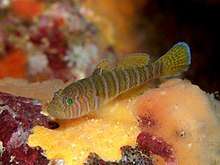Priolepis cincta
Priolepis cincta, commonly known as the girdled goby, is a species of goby fish described by Regan in 1908.[1]
| Priolepis cincta | |
|---|---|
 | |
| Scientific classification | |
| Kingdom: | Animalia |
| Phylum: | Chordata |
| Class: | Actinopterygii |
| Order: | Gobiiformes |
| Family: | Gobiidae |
| Genus: | Priolepis |
| Species: | P. cincta |
| Binomial name | |
| Priolepis cincta (Regan, 1908) | |
| Synonyms | |
Distribution
It's distributional range extends from the Red Sea to Tonga, then from Japan to the Great Barrier Reef.[2] It can be found in Brackish water and Salt water, with a depth range of 1 – 70 metres (3 ft - 229 ft), although it is usually seen at depths of 1 – 30 metres (3 ft - 98 ft).[3][4]
Behaviour
The fish is a benthic spawner.[1] They tend to hide in caves and crevices, and can also be found in corals.[5] It is a Monogamous fish and are an average length of 7 centimetres.[6][7] The species is used in aquarium commercial use by humans.[1]
Etymology
The name Priolepis is combined from two words from the Greek Language: prio is translated as "to saw" while lepis means "scale". cincta derives from the Latin word cinctum which can translate to either a girdle or bird, which is in reference to its colour pattern.[1]
References
- "Priolepis cincta (Regan, 1908)". FishBase - Academia Sinica. Retrieved 24 January 2015.
- Winterbottom, Richard; Burridge, Mary (October 1993). "Revision of Indo-Pacific species possessing a reduced transverse pattern of cheek papillae, and predorsal scales (Teleostei; Gobiidae)". Canadian Journal of Zoology. 71 (10): 2056–2076. doi:10.1139/z93-291.
- John E. Randall; Gerald R. Allen; Roger C. Steene (1997). Fishes of the Great Barrier Reef and Coral Sea (Rev. and expanded ed.). Honolulu: University of Hawaii Press. p. 506. ISBN 978-0824818951.
- Kuiter, Rudie H. (1993). Coastal fishes of south-eastern Australia. Honolulu: Univ. of Hawaii Press u.a. p. 437. ISBN 978-0824815233.
- Myers, Ewald Lieske ; Robert (1996). Coral reef fishes : Caribbean, Indian Ocean and Pacific Ocean ; including the Red Sea (1. ed., repr. with corr. ed.). London [u.a.]: HarperCollins. p. 400. ISBN 978-0002199742.
- Whiteman, EA; Côte, IM (May 2004). "Monogamy in marine fishes". Biological Reviews of the Cambridge Philosophical Society. 79 (2): 351–75. doi:10.1017/s1464793103006304. PMID 15191228.
- Kulbicki, M.; Mou Tham, G.; Thollot, P.; Wantiez, L. (1993). "Length-weight relationships of fish from the lagoon of New Caledonia" (PDF). Naga, the ICLARM Quarterly. 16 (2–3): 26–30. ISSN 0116-290X. Retrieved 24 January 2015.